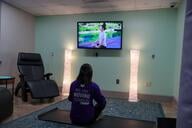You have /5 articles left.
Sign up for a free account or log in.
Day after day, college administrators and public commentators ask, what will it take for higher education institutions to reopen and stay open safely? But such conversations continue to prioritize the health and safety of students and faculty over custodial staff members -- the workers who make starting college possible and for whom institutions never closed.
The exclusion of custodial workers from these conversations reflects a broader culture of race- and class-based inequality that has threatened and continues to threaten the health and safety of custodial staff, as well as colleges at large. At a time when COVID-19 has heightened inequity in higher education, the experiences of racialized custodians reveal how a culture of inequality will continue to hurt the health and safety of campus communities.
In 2017 and 2018, I conducted a study with six custodians about their experiences working in a higher education institution. This study focused on Latinx immigrant men who work as second-shift custodians at a predominantly white public research university. The study took place in a national context in which people of color are overrepresented in college service and maintenance positions. Throughout the study, participating custodians shared how administrators, students and faculty members used health and safety protocols as a disciplinary tool to maintain race- and class-based hierarchies within the university.
Specifically, participants (whose names appear as pseudonyms here) shared instances when other people on the campus interfered with their daily efforts to clean university spaces. One participant, Jesus, was born in Mexico and, at the time of the study, had worked for the university for almost 20 years. He reported receiving glares from a student when he tried to prevent her from disposing hazardous materials unsafely.
Another participant, Henry, was a trained electrician in Cuba and had been working for the university since he moved to the United States as an adult. On one occasion, Henry said, he moved a pair of shoes outside a lab in order to clean the area. He then reported receiving a note from the shoes’ owner warning Henry not to touch the owner’s possessions because it might infect that person with bacteria. Henry also described trying to help a lab technician fix a machine only to receive word from his supervisor that the technician had filed a complaint he was breaking health and safety protocol.
Those instances demonstrate how noncustodial university members can attempt to correct, control, silence and punish custodians under the rationale of health and safety. By doing so, they undermine a custodian’s ability to engage in work that furthers the health and safety of the broader university community.
Jesus and Henry’s experiences show how health and safety protocols have, in fact, functioned not to protect the health of those in the university but to sustain custodians’ place in a broader university caste system. These protocols functioned as a mode of discipline to ensure that custodians did not exceed their positions as raced and classed workers. Henry and Jesus were perpetually reminded that, in their position, they had no right to make demands of others or to enforce institutional policies with which they must comply. Despite attempting to teach policies that would benefit the broader university community, Henry and Jesus faced university actors who used their positions of privilege in order to enforce university race and class hierarchies -- even when those hierarchies worked against their own safety.
So in the context of COVID-19, what can Jesus and Henry’s experiences tell colleges and universities about health and safety? They tell institutions that, in practice, health and safety efforts can function not to protect individuals but to protect institutional inequality. They tell them that, if racial superiority and fear continue to be woven into efforts to reopen, it may amplify surveillance of custodians around specific COVID health and safety protocols. It may increase inequitable enforcement of social distancing, create more segregation and reinforce practices and policies that continue to punish custodians for working within inequitable labor systems.
Instead, supporting the health and safety of universities must mean supporting our custodial staff members. That will require college administrators to interrogate structural racism and provide material and structural supports for custodians. Two custodial workers at Harvard University, Maren R. Ceja and Doris Reina-Landaverde, for instance, have called for adequate amounts of personal protective gear and safe work conditions. And as detailed in The New York Times, college custodians have joined custodial workers in a variety of sectors who report being asked to clean without adequate supplies, guaranteed hazard pay, sick leave and health care.
In addition to adequate supplies and material conditions, college custodial workers must be given ample, formalized opportunities to inform administrative policies. Their accounts highlight the conditions that continue to protect and benefit individuals at colleges and universities unequally. Their firsthand accounts also provide insight into how to keep people safe.
Challenging the racial and social injustice that campus custodial staff experience requires all members of college and university communities to continuously interrogate their behavior. If and when all students, staff and faculty return to campuses, they can and should play a role in combating the interlocking systems of racism, classism and xenophobia that impact the daily lives of custodians of color.
At a minimum, people on campuses must stop questioning and surveying custodians in ways that challenge their knowledge and experience and prevent them from doing their jobs. They must recognize that their impulses to correct, control, silence and discipline custodians in the name of health and safety uphold everyday systems of inequality in higher education. Instead, they should listen, recognize and respect custodians’ expertise, and welcome their efforts to keep the broader campus community safe.




